ستناقش المقالة تاريخ المواجهة بين
Acorn و
Sinclair Research LTD والعديد من الشركات الأخرى من أجل الحق في تطوير جهاز كمبيوتر للبرنامج التعليمي لشركة
BBC البريطانية . كما يتم تقديم مراجعة مفصلة للفائز في هذه المسابقة ،
بي بي سي مايكرو . لمزيد من التفاصيل ، أدعوك إلى Cat.

في أوائل الثمانينيات ، بدأت بي بي سي
مشروع محو الأمية الحاسوبية وخططت لإطلاق سلسلة من 10 حلقات
برنامج الكمبيوتر .
للقيام بذلك ، كانوا بحاجة إلى جهاز الكمبيوتر الخاص بهم. مواصفات المشروع التفصيلية ، تأليف
John A. Call ، متوفرة
هنا .
مواصفات المخطط التفصيلي لنظام MICROCOMPUTEROutline specification for the BBC MICROCOMPUTER system
This specification does not set out to be definitive
but it represents a desirable set of characteristics
which we should like to aim at for a BBC system.
Certain of these characteristics are in our view
essential and these can be clarified at a later date.
SOFTWARE
We fully realise that all microcomputers have different
dialects. The BBC is investigating the possibility of
supporting a version of BASIC which is not implemented
yet on any single machine but which would be as
compatible as possible with existing practice and
could be made available within the public domain to
any manufacturer willing to implement it. The specification
in draft form is available on request. Meanwhile, you will
see that the most desirable 'fallback' is specified below.
BASIC: The general syntax of all commands should be identical to Microsoft BASIC
5.0 (repeat 5.0). If there is any conflict between what is said below
and the relevant Microsoft implementation then the latter should be used.
Graphics and I/O are outlined later.
The following commands and statements should be implemented in
floating point arithmetic to 6 figure accuracy over a range of at
least +-10^38
DIM OPEN
OPTION BASE (0 or 1) CLOSE
DEF FN INPUT
IF ... THEN ... ELSE PRINT
GOTO ?
GOSUB LINPUT
RETURN GET
ON ... GOTO PUT
ON ... GOSUB RND
ON BREAK GOTO READ
ON ERROR GOTO DATA
CONT RESTORE
RESUME CLOAD
FOR ... TO ... STEP CSAVE
NEXT CVERIFY <<Annotation: REWIND>>
RUN CMERGE
RANDOMIZE LIST
NEW LPRINT
DELETE LLIST
PEEK PLOT
POKE MPLOT
USR LINE
STOP MLINE
RENUMBER POINT
TRACE MPOINT
WHILE ... ENDWHILE ORIGIN
INP, OUT MORIGIN
SIN, COS, TAN, ATN, INT, ABS, SGN, LOG, EXP, POS, TAB, FRE, SQR
+ - * / ^ ( )
+ (string concatenation operator)
< <= <> => =
AND OR NOT
ASC, CHR$, LEN, LEFT$, MID$, INSTR, STR$, VAL
Variables names should be as long as the user wishes with the first
two characters being significant. Examples of legal variables would be
X, X1, KM, LENGTH, A3$, NAME$ and illegal names would include 3A (must
start with letter), TO$ (reserved keyword), PER POUND (no spaces).
2 John A. Coll
Odds and ends: Powers of negative integer numbers [Y=(X)^Z] should evaluate
correctly - at least for Z<15.
Multidimensional string and numeric arrays.
Strings with totally dynamic memory useage.
It should be possible to say IF A$<B$ THEN ...
*Useful option MID$(A$,4,3)="cat".
Timed single character input.
I/O should be channel oriented using the word ASSIGN to assign a
logical channel to a physical device (eg ASSIGN OUTPUT TO PRINTER or
ASSIGN #4 TO DISK0, "MYPROG")
Graphics: the software should include commands to at least
(a) Plot an alpha-numeric character or string at any place on the screen
(PLOT X,Y,A$)
(b) Plot a low resolution graphics point to build Teletext graphic
characters in a range of colours or shades of grey (minimum: black and
white) (PLOT X,Y,C probably C=-1 to complement point, C=0 to plot
black point .... C=7 to plot white point)
(c) Find out what is at the point X,Y ( C=POINT(X,Y) or A$=POINT(X,Y))
(d) Draw a line from the last specified point to the new co-ordinates (LINE
X,Y,C)
(e) Move the effective origin (ORIGIN=X,Y)
(f) Do all the above in medium resolution graphics with similar commands
MPLOT X,Y,C
MLINE X,Y,C and
C=MPOINT (X,Y)
MORIGIN=X,Y
(f) Illegal values of X,Y or C should be ignored.
Video display: Either
(a) an integral single line display of 40 characters (each built from at
least 5 by 7 dots) and a modulated UHF output of the full screen (see
below) or
(b) an integral display of the full screen plus a modulated UHF output of
the full screen or
(c) a modulated UHF output of the full screen
A composite video output should be included.
The 'full screen' should consist of at least 24 lines of 40 characters
(*preferably an option of 80 characters from the outset) of upper and lower
case alpha-numerics and (colour) Teletext graphics. These should be capable
of being freely mixed with (colour) medium resolution graphics of at least
200 horizontal points. The medium resolution graphics should be eraseable
separately from the other displays.
The computer should either produce UHF colour signals at the time of
purchase or be easily expaned to produce UHF colour signals. It must be
designed with colour Teletext and colour graphics in mind.
3 John A. Coll
The screen handler should respond to specific control characters to
(a) Home top left and clear to end of page (whole screen)
(b) GOTOXY - cursor addressing
(c) clear to end of line
(d) clear to end of page
(e) Non destructively move the cursor up/ down/ left/ right
(f) Move to start of line (carriage return)
(g) Delete previous character
(h) Scroll when on bottom line of display
(i) Clear medium resolution graphics display
Keyboard: capable of generating all 128 ASCII codes. Positive action keys (not
touch sensitive). ISO standard layout plus
(a) Up/down/left/right cursor control
(b)*A row of keys, above the numbers, which generate software definable
codes - this could be done with a software look-up table to map the
original codes to new values.
Loudspeaker: inside box and accessible from BASIC
Printer connection: electrically to RS449 (or RS232C) with the connector to ISO
2110. Only Send Data, Receive Data, Request to Send and Clear to Send need
be implemented.
Paddles: some connector to which two simple potentiometers may be connected the
setting of which can be determined by a simple BASIC statement or a few
lines of assembler program.
Teletext: adapter should be available for off-air downloading of software
Expansion port: fully electrically buffered expansion connector (eg no
unprotected MOS!).
Memory: sufficient within the box to support floating point BASIC and medium
resolution graphics. This probably means 16K ROM plus 32K RAM - certainly
at least 16K RAM should be supplied at the outset.
Memory map: above all this should be designed for expansion and standardisation.
Probably should be RAM from 0000 up with ROM from FFFF down (including
8080/Z80 systems). At the very top there should be a simple monitor with
any ROM high level languages immediately below. The screen should not be
allocated to fixed RAM locations below C000 and could be dynamically
allocated from available RAM. Scratchpad RAM for the stack and monitor, and
RAM for the DOS should, preferably, be well clear of low memory RAM (6502
problems here) used for user programs.
System monitor: should contain routines to
(a) output character to screen
(b) test keyboard for character waiting
(c) get character from keyboard
4 John A. Coll
(d) send character to printer
(e) load and save binary files from cassette
all the above should vector via RAM locations to default ROM device drivers
(f) examine and change memory locations.
Device handlers: Cassette, paddles and printer should also be driven via RAM
vectored device drivers.
Cassette interface: producing CUTS frequencies, but doing all the byte recovery
in software. The software should be insensitive to reversed phase play back
from a cassette recorder, work at 1200 bps, accept and produce the BBC
format tape (as well as your own format if you wish). Named files,
catalogue, idiot proof.
The manufacturer should be able to demonstrate a production model disk operating
system which should, at least:
Enable a user to plug the thing in and, without pressing a single button,
end up running a BASIC program - or any other program that the machine
had been configured to run.
Give a 'DIRectory' or 'CATalogue' of files on disk showing filenames, file
length, creation date, whether or not the file is delete-protected
Save a specified area of memory as a named binary file
Load and automatically execute binary files
Save onto disk ASCII text or data from BASIC etc.
Load text from disk
LIST a text file to screen or printer
EXECute an text file as if it were a 'command line' - including refernces
to any disk drive or any peripheral
Delete and rename specified files or groups of files
Permit random access to data in multiple files
Have a well organised JUMP list at a known location to all routines likely
to be needed by assembly language programmers.
The Disk Operating System should appear as a byte oriented input/output
stream similar to the keyboard/VDU and data should not need to be
blocked before being passed to the DOS
At least 10 disk channels should be capable of 'simultaneous' access (ie
OPEN concurrently)
Faulty disk sectors should be automatically avoided
Accidental swapping of disks should not either (a) crash the disk file
structure or (b) abort everthing
The vast majority of the DOS high level commands (such as CAT, DIR, COPY,
LIST, DELETE, RENAME, PROTECT, SAVE) should not form part of the
permanently memory resident DOS. They should be Utility or Transient
programs called into memory when required. All those listed above
should not reside in the same memory space as BASIC or as the EDITOR
or WORD-PROCESSOR. They should all be able to be called from BASIC
etc. The manufacturer should be able to SHOW an extensive range of
such transients and should not say 'Oh that would be very easy to
write'!
5 John A. Coll
→
المصدر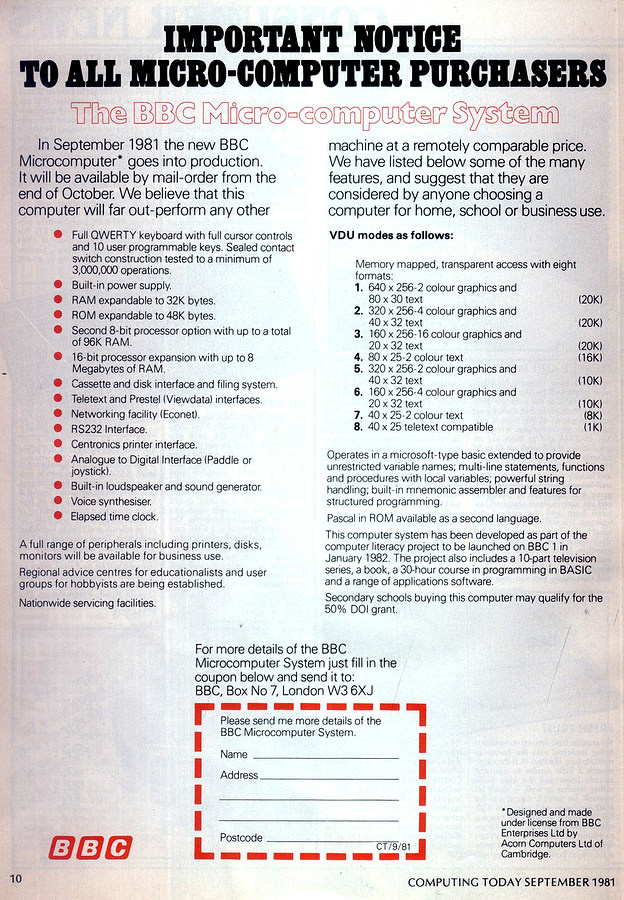 المصدر
المصدرفي البداية ، اختارت هيئة الإذاعة البريطانية في الواقع
حاسوب Grundy NewBrain ، الذي بدأ تطويره في شركة
Clive Sinclair's Sinclair Radionics ، ولكن في عام 1980 تم إعلان إفلاسها وتصفيتها ، وتم نقل المشروع نفسه إلى
مختبرات Newbury .
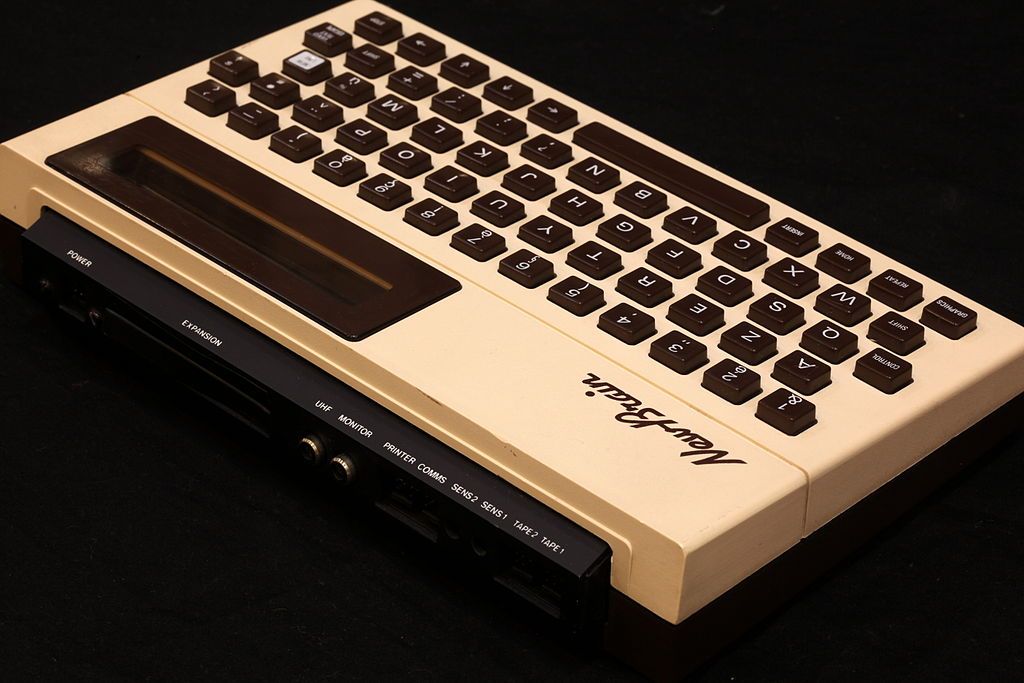
المصدر
wikipedia.orgلم يلب جهاز الكمبيوتر المقدم توقعات ومواصفات هيئة الإذاعة البريطانية ، وتم رفض العرض. أعلنت الشركة عن بدء مسابقة تطوير الكمبيوتر ، وانضمت إلى المعركة كلا من شركة Clive Sinclair الجديدة
Sinclair Research والشركة الصغيرة
Acorn ، التي أسسها الموظف السابق في Sinclair Radionics
كريس كاري وصديقه هيرمان هاوزر. كان لدى Acorn بالفعل كمبيوتر
Acorn Atom في وقت الإعلان عن المسابقة ، وكان الفريق يعمل على إصدار جديد من
Acorn Proton ، وأصدر Sinclair Research
ZX80 وكان يعمل بنشاط على
ZX Spectrum .
نشر ريتشارد راسل ، أحد مطوري بي بي سي بيسك ، عددًا من الوثائق المثيرة للاهتمام في منتدى
stardot.org.uk ، وخاصة عرض
أكورن وخطة لإدارة بي بي سي
للقاء المطورين. كان ريتشارد نفسه حاضرًا أيضًا في هذا الاجتماع ، الذي عقد في 12 فبراير 1981 ، حيث تمت دعوة ممثلي Acorn و Newbury Lab و Tangerine و Commodore في نهاية المطاف. في المنتدى ، يكتب ريتشارد أن Transam و Nascom و
Sinclair كانوا أيضًا على القائمة الأولية ، ولكن في النهاية ، لم تدرج بي بي سي حتى العرض المقدم من Sinclair في الدعوة.
السبب وراء عدم وصول سنكلير إلى الاجتماع الأخير هو عناد كليف سنكلير نفسه. في
كتاب The Legacy of the BBC Micro ، يشير المؤلف إلى رسالة من المنتج التنفيذي لـ BBC John Radcliffe تفيد أن فريق المشروع كان لديه مراسلات نشطة مع Clive. كان أحد التناقضات هو أن المعيار الأساسي تم تطبيقه في Sinclair ، وكانت BBC تريد نسخة معدلة قليلاً ، ولم يكن لدى Clive Sinclair رغبة خاصة في إعادة إصدارها. شهدت بي بي سي Sinclair بيع ZX80 بنجاح والاستعداد لإطلاق نموذج جديد. كانوا يعتقدون أن Sinclair لن تكون مستعدة لتغيير مواصفات جهاز الكمبيوتر الخاص به بجدية ، ونتيجة لذلك ، ستحصل الشركة على ZX Spectrum قياسي بألوان بي بي سي. على العكس من ذلك ، أظهر Acorn استعدادًا تامًا للقيام بالضبط بما يطلبه مهندسو BBC. اتصل كريس كاري بهيئة الإذاعة البريطانية وأعلن استعداده لإظهار نموذج أولي فعال. كان لدى فريق Acorn بضعة أيام فقط لتحسين بروتون لمواصفات بي بي سي. تم تحديد موعد العرض التقديمي في الساعة 10 صباحًا الجمعة ، مساء الخميس ، ولم يعمل النموذج الأولي بعد.
كما ذكر ستيف فيربر ، أحد أعضاء فريق Acorn: "لقد تعبنا جميعًا للغاية ، لكن هيرمان كان قادرًا على تحفيز الفريق. كانت وظيفته هي الخروج وشراء الشواء. لقد صنع الشاي أيضا. فعل ذلك لدعم الفريق. نظرنا جميعًا إلى هذا الشيء ، الذي لا يزال يرفض العمل ، واقترح هيرمان شيئًا مثل "قطع الحبل السري من النموذج الأولي إلى نظام التطوير ودعه يعمل بشكل مستقل".
على ما يبدو ، كانت إشارة مزامنة من لوحة التصحيح إلى النموذج الأولي. ساعد هذا القرار ، وبحلول الساعة 7 صباحًا يوم الجمعة كان لدى الفريق نموذج أولي فعال. كان من المفترض أن يصل ممثلو بي بي سي إلى 10 ، وبحلول هذا الوقت كان النموذج الأولي ينفذ بالفعل برامج حقيقية على Basic ، بعد ذلك بقليل كان من الممكن بدء الجدول الزمني. في بعض المؤشرات ، تجاوز حتى المتطلبات المذكورة.
ترك هذا العرض انطباعًا كبيرًا على هيئة الإذاعة البريطانية ، وقد أحبوا أيضًا موقف الفريق تجاه المشروع والتفاني الذي عملوا معه في النموذج الأولي.
بعد الاجتماع الأخير ، اختارت بي بي سي Acorn. وهكذا بدأت قصة أحد أشهر أجهزة الكمبيوتر في بريطانيا -
بي بي سي مايكرو.في عام 2009 ، أصدرت هيئة الإذاعة البريطانية (بي بي سي) الفيلم الروائي
الصغير مين عن تاريخ تطور صناعة الكمبيوتر في بريطانيا ، والذي يُظهر بشكل موثوق المواجهة بين سنكلير وأكورن. أوصي بشدة بمشاهدة هذا الفيلم لأي شخص مهتم بتاريخ الكمبيوتر ، خاصة أنه متاح مع الترجمة.
بعد ذلك ، أقترح الانتقال إلى مراجعة
لنموذج BBC Micro B ، الذي أطلق عليه المستخدمون اسم
Beeb .
لذلك ، في 1 ديسمبر 1981 ، تم إطلاق طرازين في السوق: نموذج BBC Micro A بسعر 235 جنيهًا إسترلينيًا و BBC Micro نموذج B بسعر 335 جنيهًا إسترلينيًا. نظرًا للتضخم ومن حيث الدولار ، فإن هذا هو 860 دولارًا و 1225 دولارًا على التوالي - ليست رخيصة جدًا لأجهزة الكمبيوتر المنزلية الضخمة.
وهو عبارة عن قطعة واحدة كبيرة الحجم (بالمقارنة مع ZX Spectrum) ، حيث يوجد الكمبيوتر نفسه ولوحة المفاتيح في حالة واحدة. المعالج المركزي هو
MOS 6502 ، يعمل بتردد 2 ميجا هرتز. تم بناء
Atari و
Apple II عليه. اختلفت النماذج التي تم إصدارها في مقدار ذاكرة الوصول العشوائي (في النموذج A كان 16 كيلوبايت ، في النموذج B كان 32 كيلوبايت) ، بالإضافة إلى أوضاع الفيديو المدعومة. كانت ذاكرة ROM بحجم 32 كيلوبايت وتحتوي على BBC Basic - إصدار مطور خصيصًا من Basic يستند إلى Microsoft Basic v.5.0. يحتوي الكمبيوتر على لوحة مفاتيح مريحة من 74 زرًا ، والتي تبدو أكثر صلابة وموثوقية من ZX Spectrum.

في الزاوية اليمنى فوق لوحة المفاتيح يوجد شعار الشركة لمشروع محو الأمية الحاسوبية - بومة بكسل.
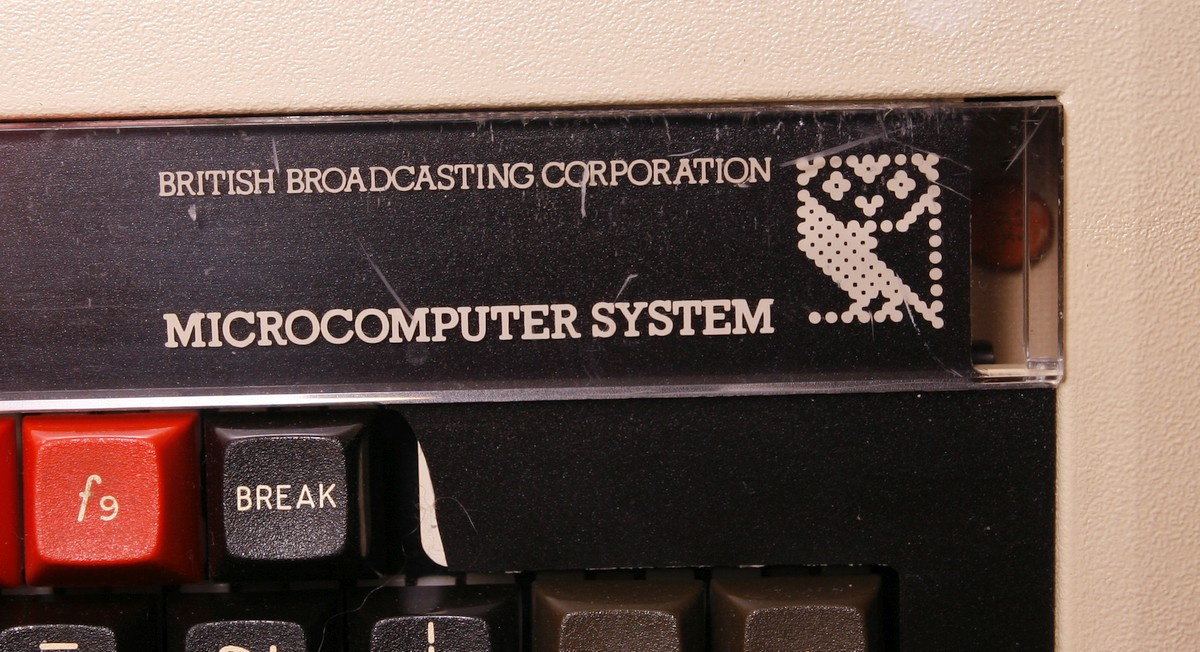
على اللوحة الخلفية لـ BBC Micro ، توجد واجهات للتوصيل بمدخل هوائي التلفزيون ، ومخرج شاشة مركب (أبيض وأسود افتراضيًا ، ولكن هناك وصلة على اللوحة تسمح لك بإخراج إشارة PAL ملونة) ، واجهة RGB للاتصال بشاشات ملونة ، RS423 للتواصل مع أجهزة RS232 ، واجهة تسجيل الشريط لتحميل البرامج وحفظها وحافلة من 4 واجهات تناظرية ، والتي يمكنك توصيل عصي التحكم ومعدات المختبر. قدم ADC دقة 12 بت.

يوجد في الجزء السفلي من الحالة في مكان مخصص ناقل نظام 1 ميجاهرتز لتوصيل وحدات التوسيع (على سبيل المثال ، Teletext) وناقل
IEEE 488 وواجهة قرص ثابت.
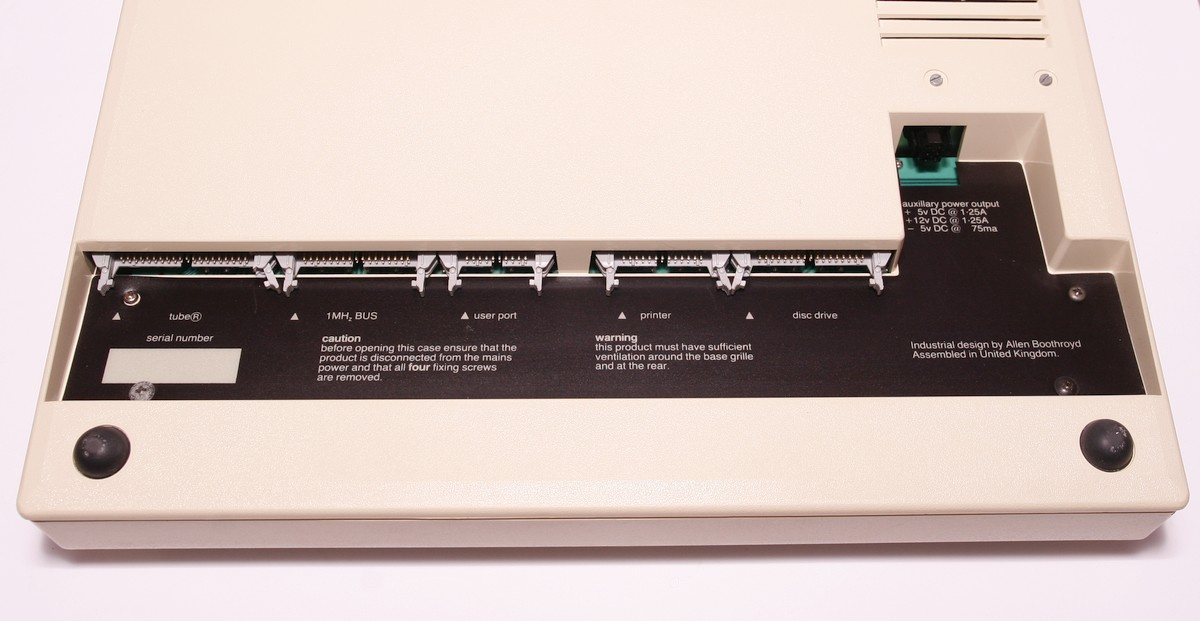
جعلت بنية BBC Micro من الممكن تثبيت العديد من الإضافات الإضافية ، مثل واجهة محرك الأقراص ، لغات إضافية عالية المستوى في ROM. حتى أن Acorn طورت معيار LAN الخاص بها ،
Econet ، والذي يسمح بالربط الشبكي لما يصل إلى 255 كمبيوتر. كان دعم هذا المعيار في نواة لينكس حتى عام 2012 ، وبعد ذلك تمت إزالته بسبب الثغرات الأمنية.
ميزة أخرى مثيرة للاهتمام كانت القدرة على ربط معالج Z80 إضافي بذاكرة 64 كيلوبايت الخاصة به للتوافق الكامل مع نظام التشغيل
CP / M الشهير في ذلك الوقت ، والذي تم تطوير ناقل خاص به يسمى Tube.
يوجد داخل العلبة لوحة كبيرة إلى حد ما ، يمكن العثور على تفاصيلها في
دليل الخدمة .
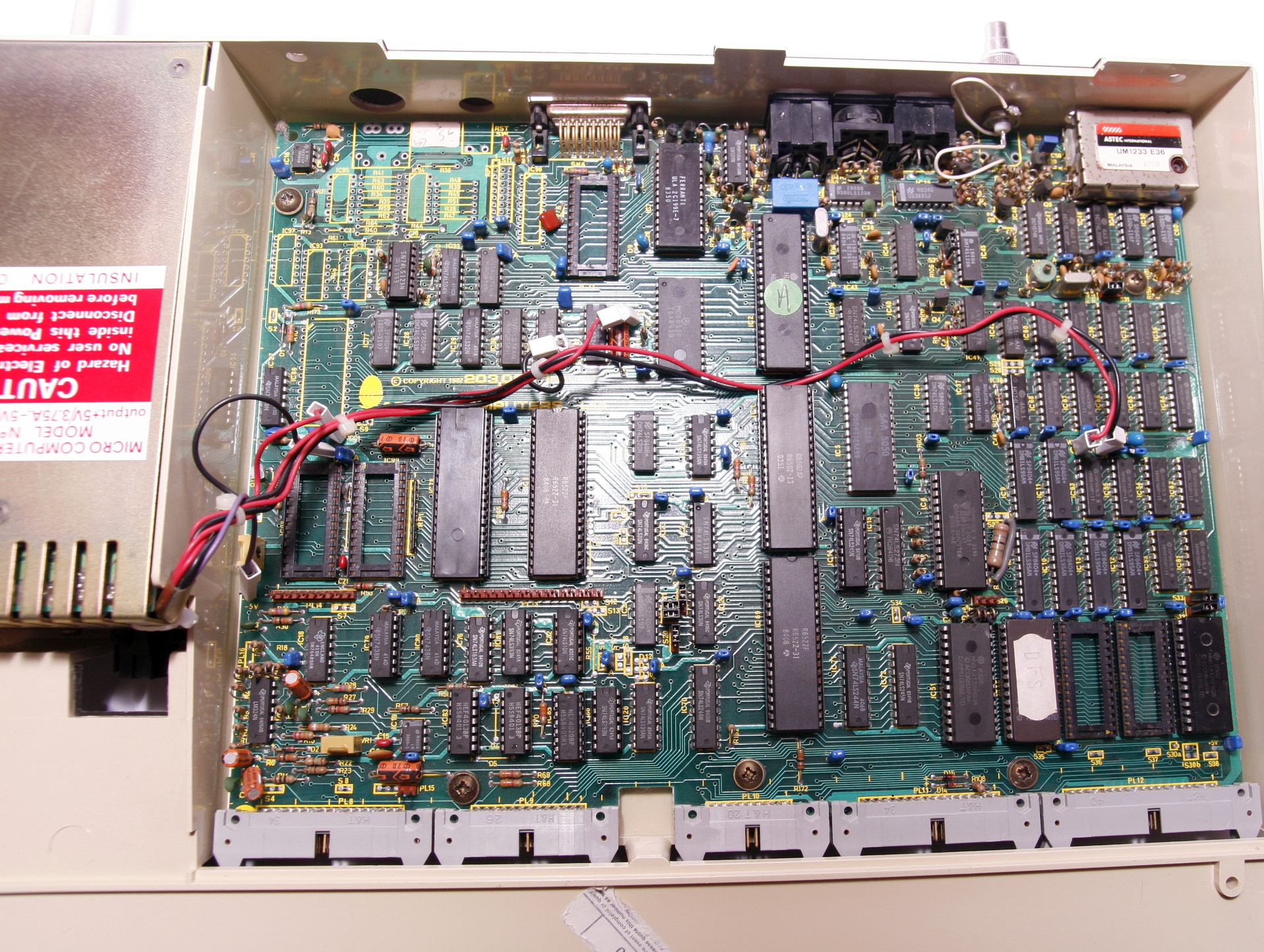
هيكل المجلس
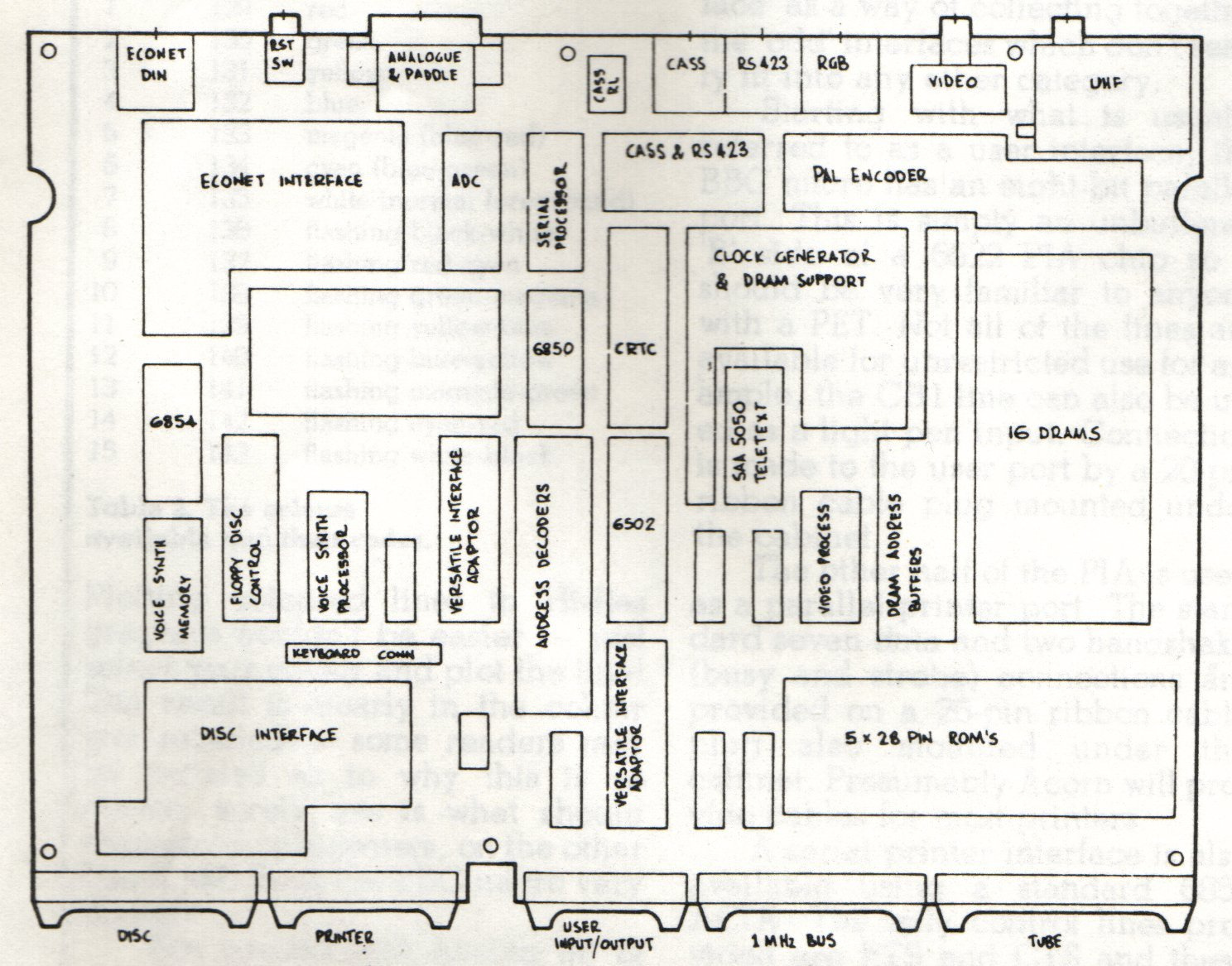
تم تصوير شعار Acorn على اللوحة ؛ لقد حصلت بالفعل على المراجعة السابعة للوحة.

كما تم تضمين الكمبيوتر مع مواد إعلانية بمواصفات للكمبيوتر ووحدات توسعة له ، بالإضافة إلى
تعليمات وعلبة برامج لمشروع محو الأمية الحاسوبية.

نظرًا لأن المشروع كان مشروعًا تعليميًا ، فقد تم أيضًا تطوير برنامج لتعليم اللغة الأساسية للكمبيوتر ونشر العديد من الكتب المدرسية.
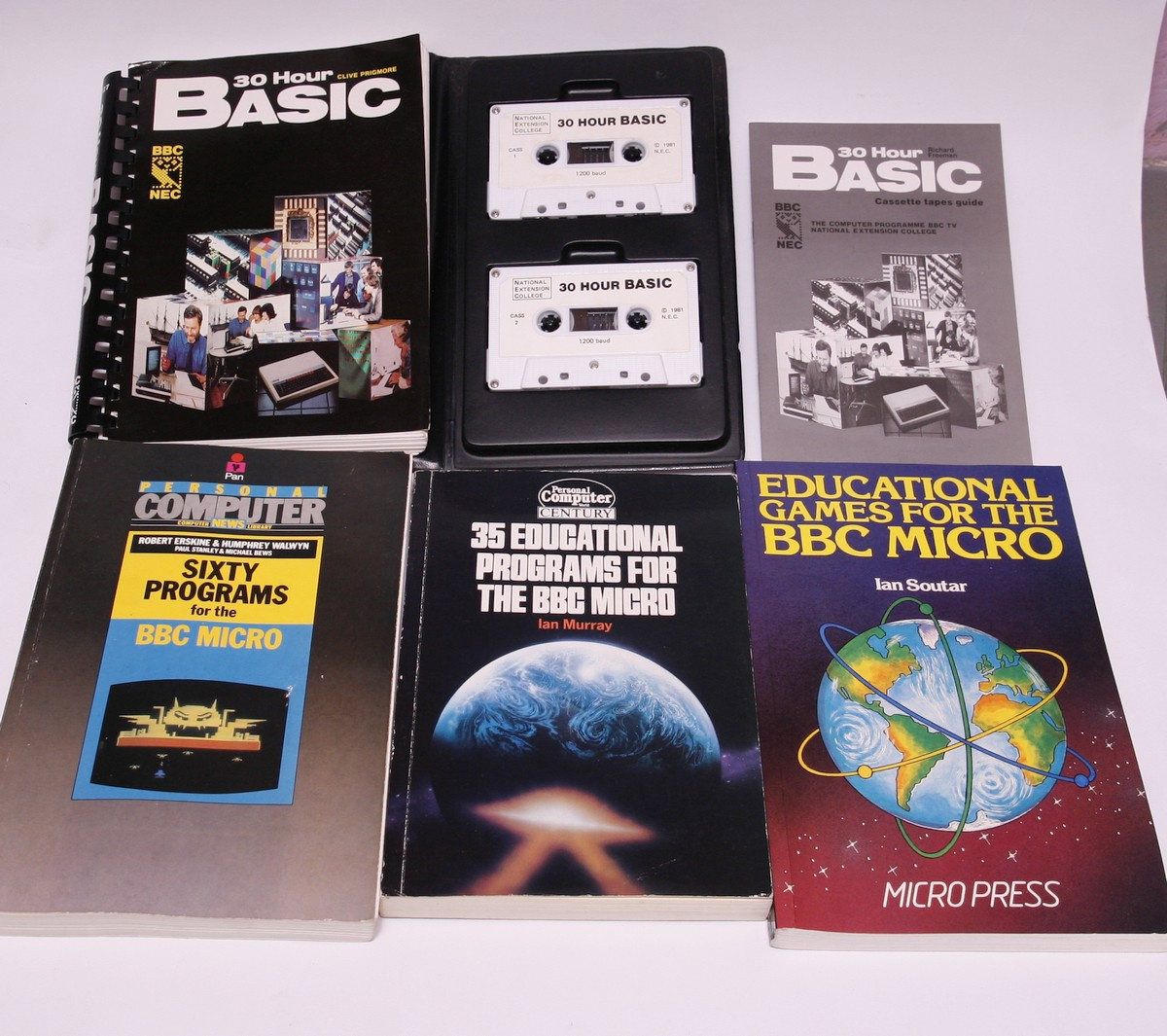
بالطبع ، كانت ألعاب بي بي سي مايكرو كذلك.
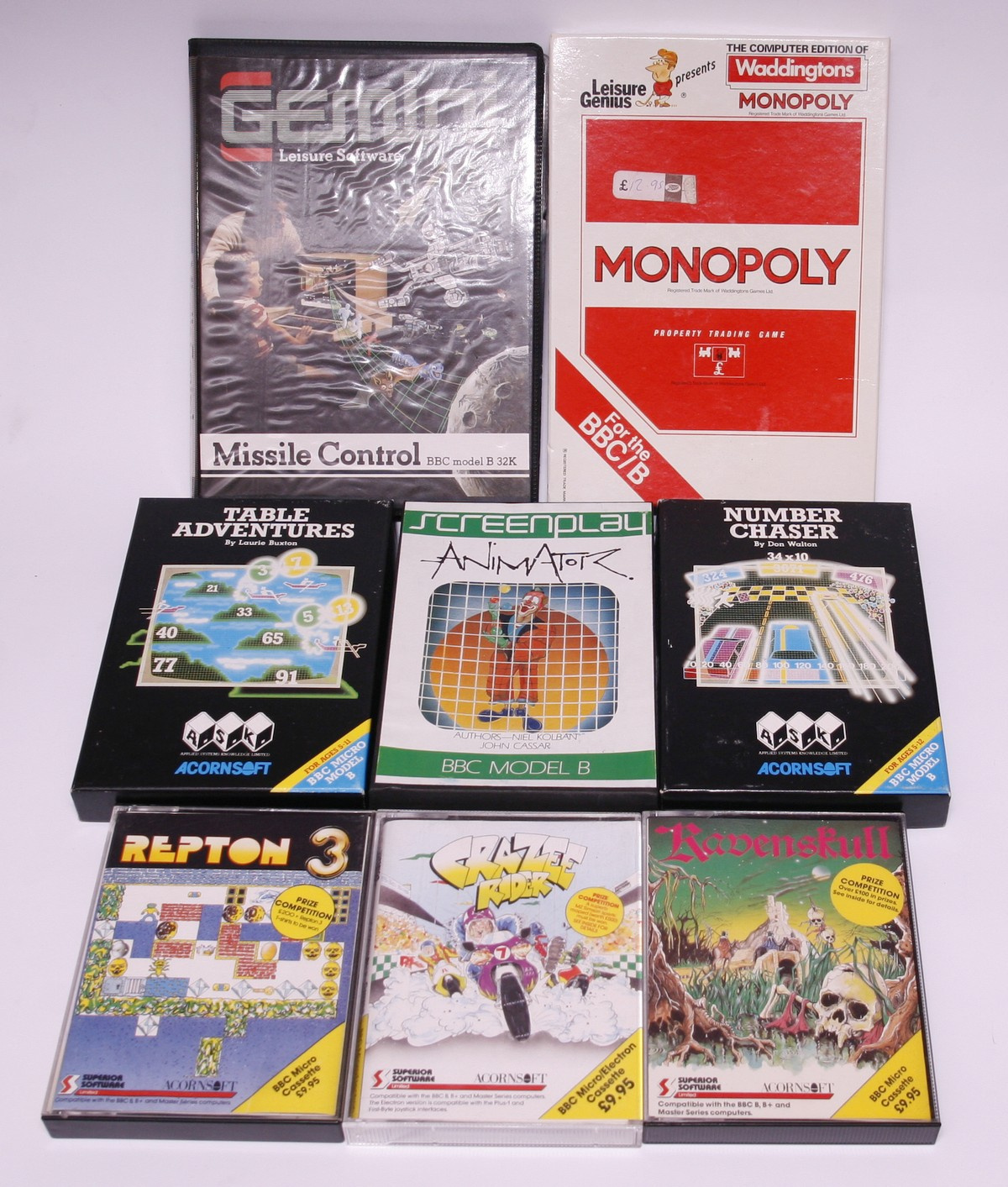
واحدة من أشهر محاكاة الفضاء -
Elite - كتبها Acornsoft خصيصًا لـ BBC Micro (لدي النسخة الأصلية المعبأة). في وقت لاحق تم إعادة نشر هذه اللعبة للعديد من أجهزة الكمبيوتر الأخرى.

لمستخدمي كمبيوتر Acorn ، تم إصدار مجلة Acorn User أيضًا. كما هو الحال في مجلات الكمبيوتر الحديثة ، احتلت الإعلانات ما يصل إلى 30٪.
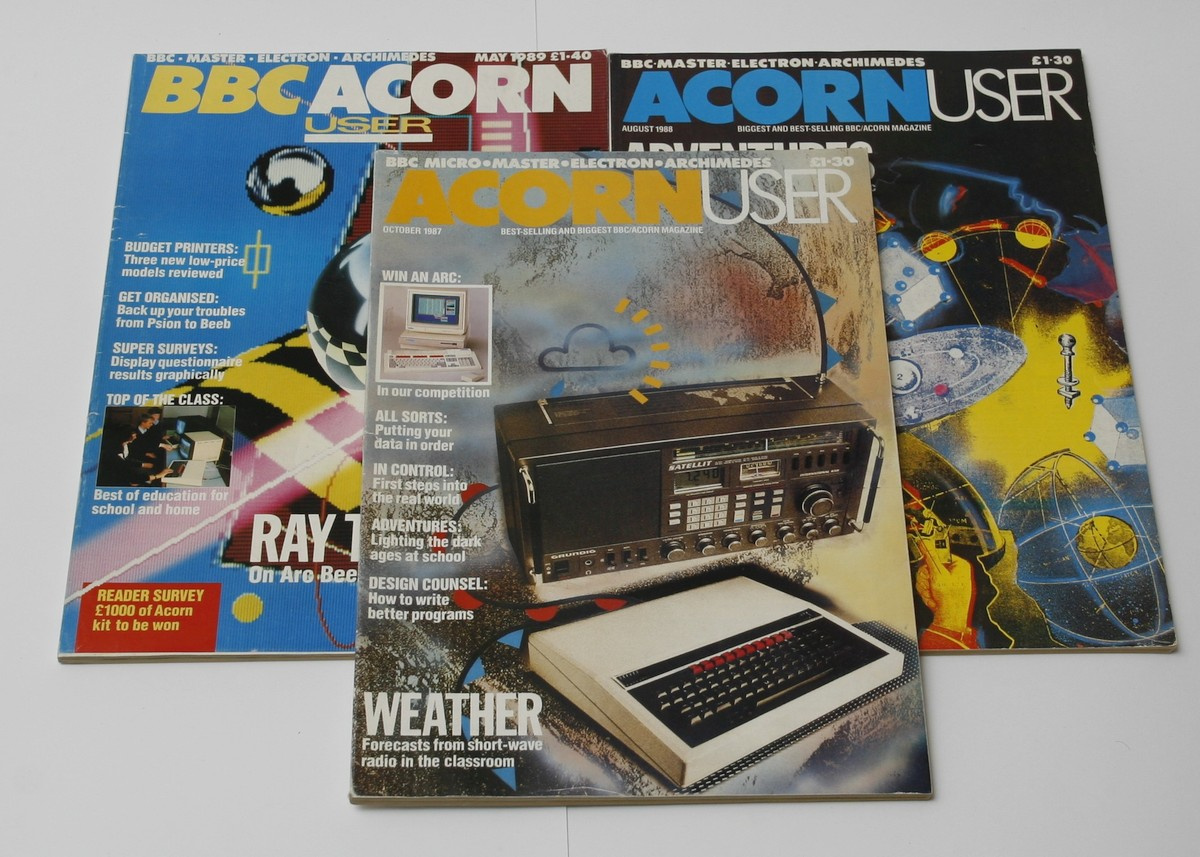
حسنًا ، حان الوقت لتشغيل Beeb. يُظهر الفيديو تنزيل وعرض ألعاب
Elite و
Monopoly و
Repton 3 . من فضلك لا تحكم بدقة على جودة الفيديو. اضطررت إلى إجراء تعديلات صغيرة على الكمبيوتر للحصول على صورة ملونة من الإخراج المركب - افتراضيًا ، يتم عرض صورة بالأبيض والأسود فقط عليه. وبسبب هذا ، أصبح وميض الصورة أكبر.
تحتوي الشبكة أيضًا على محاكي BBC Micro عبر الإنترنت يساعدك في الحصول على فكرة أفضل عن هذا الجهاز -
bbc.godbolt.orgقصة Acorn لا تنتهي عند هذا الحد. بعد BBC Micro ، أصدرت الشركة أيضًا
Acorn Electron - نسخة مبسطة من Beeb ،
ماجستير في BBC مع ذاكرة 128 كيلوبايت ، خط من أجهزة كمبيوتر
Acorn Archimedes التي تستخدم معالجات RISC 32 بت من إنتاجها الخاص ، ولكن مساهمة Acorn الأكثر أهمية في صناعة الكمبيوتر هي تطوير
بنية ARM ، والتي أصبحت الآن تعمل كمية كبيرة من الإلكترونيات من الهواتف الذكية إلى السيارات الكهربائية.
في إطار المتابعة ، أخطط لمراجعة قصيرة لـ
Acorn Electron ، والمواد الموجودة عليها جاهزة تقريبًا ، كما يتم إعداد مقال حول
Sinclair QL ، ولكن كانت هناك بعض الصعوبات في ذلك: لقد جف كابل الشريط في لوحة مفاتيح الفيلم ولا يعمل ، تحتاج إلى طلب فيلم جديد أو محاولة استعادته.
شكرا لكم على اهتمامكم.